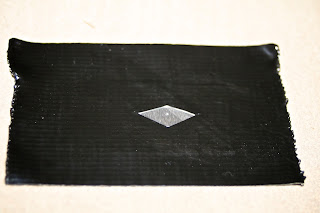I took a few days off from photography this week. The weather has been bad and is taking a turn for the worst while I write this. It is about -20 something C outside and snowing.
Last weekend I finished all the cameras. It is pretty simple DIY stuff really. I mean, looking at the pictures below should basically be self-explanatory. But here goes anyway.
This is how the cans and tins turned out after a good nights rest. Nice and flat black. Everything in this picture is really all you need in this stage of the process. Duck Tape (I ran out so get lots of it. Did I already mention there is no such thing as to much Duck tape?), Scissors, your pinholes of course and a little message to put on the cameras, as a final touch. Sort of...
This is how I stuck the pinholes to the cans. Easy and simpel.
Once that is done cover your whole can in tape. I hope this prevents rusting these cans out. Fingers crossed on that. Make sure you at least do any seams and corners you don't trust and the top and bottoms. I also hope that this will keep water out.
Attach your message with a piece of clear tape.
Make a shutter and stick it on the cam like this. I rolled one side of the tape up. This way it makes it easier to take the shutter off.
In the end you'll end up with a bunch of light tight boxes ready to be loaded with film. Which I did the same day. I got a bunch of old photo paper from my friend Suzanne. This was just perfect for my cheap 2011 DIY photo project. Free tins, free cans, free paper ... sweet. I converted my upstairs spare bathroom to a temporary darkroom. Locked myself in and stuck the paper in the tins under a safe light. After that was done every can got mated with their tops and I taped them shut. After that I numbered them and put them all in a big black plastic bag and put them in my garage. So they could acclimatise to the cold temperatures. In the morning they where basically frozen solid.
This week I started hanging them as well. I have a total of 6 up right now. 2 facing East and downtown Calgary. 3 Facing East, South and West on a friends pasture. And 1 facing West on 'some' pole in 'some' pasture, close to home. This weekend I'm planning to hang at least 2 more on 'some' undisclosed locations. :) But let me tell you hanging them WAS a challenge.
I went to Canadian Tire early this week and bought a '
100 piece Zip Tie set'. Just a heads up. THOSE ARE RUBBISH! One the first night I think about 50 snapped off. They absolutely DO NOT like the cold. So back to the drawing board. I use 18 gauge mechanics wire now. This works perfectly.
Conclusion. This is a real fun project to do in the dark winter months. I think I will keep this project going until I run out of paper but that will be a while though.
I am really excited about this project! Fingers crossed my film doesn't freeze to death first.




























